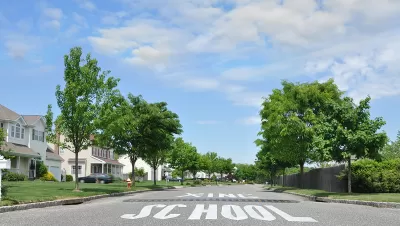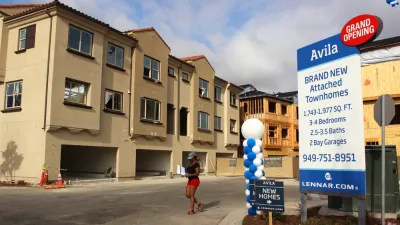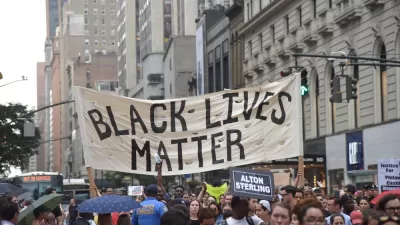African-American migration may reflect an attempt to escape poverty-related social ills rather than an attempt to escape gentrification.

A few weeks ago, I read a news story pointing out that one of Pittsburgh's suburbs was becoming more racially integrated. In particular, the story suggested that blacks were moving from East Liberty (a city neighborhood bordering more affluent areas) to Penn Hills (the inner-ring suburb in question), and that this population shift arose from the gentrification of East Liberty. This view, however, is not the only plausible interpretation of African-American suburbanization.
Throughout the late 20th century, African-Americans have been following whites into suburbia—not just in expensive, prosperous cities but in declining cities such as Detroit and Cleveland. One common pattern was that before the growth of suburbia, African-Americans lived in a few areas near downtown. In the late 20th century, middle-class blacks moved a little farther from downtown every few years, and poorer blacks moved into the areas abandoned by middle-class blacks.
In Atlanta, for example, African-Americans at first lived in Vine City, West End, and a few other neighborhoods near downtown. But in the 1960s, African-Americans moved away from downtown, and whites moved into the suburbs. By 1980, most of Atlanta's south side was virtually all-black. And in the last two or three decades, many southern and eastern suburbs became majority-black as well.
However, it seems to me that Atlanta's black suburbanization was not a result of blacks being priced out of wealthy intown neighborhoods. Instead, working- and middle-class blacks moved south to flee the poverty-related ills of older neighborhoods, much as whites had done in earlier decades.
How do we know this? If blacks were fleeing high rents, newly African-American suburbs would be poorer than older, closer-in black neighborhoods, because the poorest people would be the first to be displaced by gentrification.
But this has not been the case. For example, in majority-black Clayton County,Georgia, the median household income among black householders is just over $41,000—not enormous, but nearly 50 percent higher than the median black household income in the city of Atlanta ($27,000). The city's poorest majority-black zip code, 30314 (with a mean household income of just over $13,000) is just west of downtown.
In Pittsburgh, as in Atlanta, blacks in integrated suburbs tend to be better off than residents of the poorest areas; the median household income for black Penn Hills householders was over $40,000, much higher than in any East Liberty census tract. (Caveat: it may be that new migrants to Penn Hills are poorer than most black Penn Hills residents, in which case the "gentrification/displacement" explanation of Penn Hills integration makes more sense.)
How do Atlanta and Pittsburgh compare to expensive, rapidly gentrifying cities such as Washington, D.C? Washington's poorest areas are far from the urban core. In fact, the region's poorest neighborhoods are at the city's southeastern edge, east of the Anacostia River and west of the city limits. By contrast, even the poorest African-American suburbs of western Prince George's County are better off than Washington, D.C.'s Far Southeast. So even in rapidly gentrifying Washington, D.C. it is not accurate to equate suburbia with poverty.*
Similarly, New York City's poorest African-American neighborhoods (such as East New York and Brownsville) are at the outer edges of Brooklyn. Although parts of Long Island are black and poor, these areas are still better off than poor urban neighborhoods. For example, Wyandanch is one of Long Island's poorest suburbs. But even the poorest census tract in Wyandanch has a median household income of just over $42,000, while Brooklyn's poorest areas have household incomes in the $30-35,000 range.
In sum, black suburbanization, like white suburbanization, combines two very different trends—an older trend of middle-and working-class people fleeing poverty and a newer countertrend of middle-class people fleeing high housing costs.**
*Look up data for your city here.
**Of course, the two trends may be interrelated. If you can afford not to live in East New York, high urban rents might cause you to choose a working-class suburb over a more desirable city neighborhood.

Study: Maui’s Plan to Convert Vacation Rentals to Long-Term Housing Could Cause Nearly $1 Billion Economic Loss
The plan would reduce visitor accommodation by 25,% resulting in 1,900 jobs lost.

North Texas Transit Leaders Tout Benefits of TOD for Growing Region
At a summit focused on transit-oriented development, policymakers discussed how North Texas’ expanded light rail system can serve as a tool for economic growth.

Using Old Oil and Gas Wells for Green Energy Storage
Penn State researchers have found that repurposing abandoned oil and gas wells for geothermal-assisted compressed-air energy storage can boost efficiency, reduce environmental risks, and support clean energy and job transitions.

From Blight to Benefit: Early Results From California’s Equitable Cleanup Program
The Equitable Community Revitalization Grant (ECRG) program is reshaping brownfield redevelopment by prioritizing projects in low-income and environmental justice communities, emphasizing equity, transparency, and community benefits.

Planting Relief: Tackling Las Vegas Heat One Tree at a Time
Nevada Plants, a Las Vegas-based nonprofit, is combating the city’s extreme urban heat by giving away trees to residents in underserved neighborhoods, promoting shade, sustainability, and community health.

How Madison’s Tree Planting Efforts Are Growing a Healthier Community
Madison’s annual tree planting initiative is enhancing environmental resilience, public health, and community livability by adding 1,400 carefully selected trees citywide, with strong community and institutional support for urban forestry.
Urban Design for Planners 1: Software Tools
This six-course series explores essential urban design concepts using open source software and equips planners with the tools they need to participate fully in the urban design process.
Planning for Universal Design
Learn the tools for implementing Universal Design in planning regulations.
Ascent Environmental
Borough of Carlisle
Institute for Housing and Urban Development Studies (IHS)
City of Grandview
Harvard GSD Executive Education
Toledo-Lucas County Plan Commissions
Salt Lake City
NYU Wagner Graduate School of Public Service






























